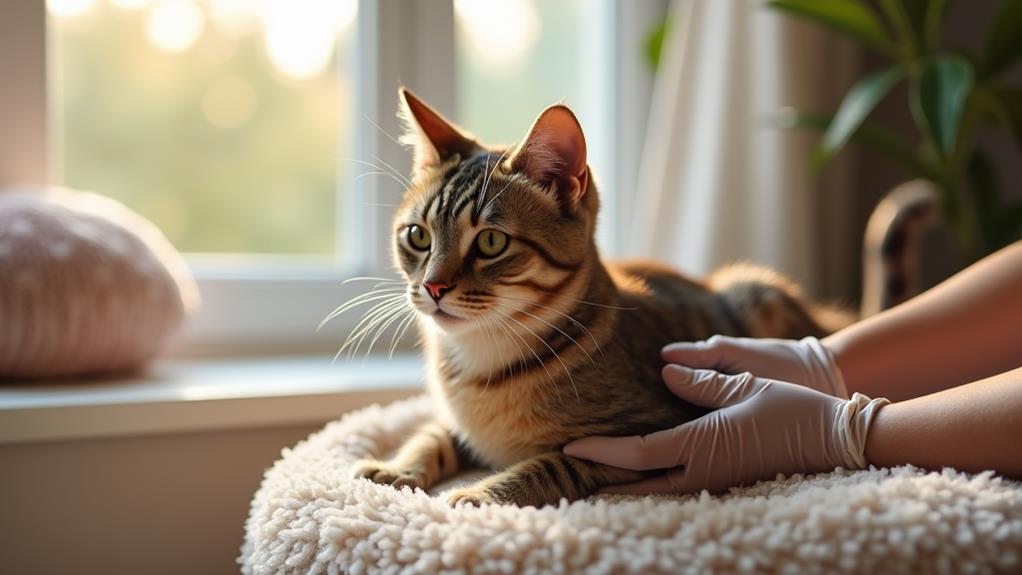How to Domesticate a Feral Cat: A Guide to Taming Wild Cats
To tame a feral cat, start by understanding its behavior and building trust gradually. Assess the cat's environment to identify its comfort level and create a safe indoor space with necessities like food, water, and a litter box. Establish a routine by feeding at consistent times, using soft voices and gentle movements. Let the cat approach on its terms and use high-value treats as positive reinforcement. Engage with interactive toys to encourage non-threatening interactions. Patience is key, as this process may take weeks or months. As you develop these techniques, you'll uncover more effective strategies for socializing wild cats.
Understanding Feral Cat Behavior
Feral cats often shy away from human interaction, displaying behaviors driven by their lack of socialization with people. Unlike their stray counterparts, feral cats have had little to no human contact, making them view humans as potential threats. This can lead to a range of fearful behaviors when approached. You might notice them hissing, flattening their ears, or adopting a crouched posture, all of which are defensive signals in their body language. These signs are essential to recognize, as they help you understand the cat's comfort level and prevent potential aggression during interactions.
Socializing a feral cat is possible, but it requires patience and understanding. The process of taming depends greatly on the cat's maturity, temperament, and past experiences. Younger feral cats might adapt more easily, whereas older ones may require more time and gentle handling. When attempting to socialize, approach slowly and observe their body language closely. Building trust is key, and it'll take consistent, gentle interactions to help them feel safe around humans. By respecting their space and gradually increasing human contact, you can guide them towards a more domesticated and comfortable life.
Assessing the Cat's Environment
As you begin the expedition of socializing a feral cat, start by evaluating its environment to tailor your approach effectively. Begin by examining the cat's behavior from a safe distance. Observe how it moves, where it hides, and how it interacts with its surroundings. This will give you insights into its comfort level and any potential health issues that might require attention. If you notice signs of illness or injury, don't attempt direct contact; instead, contact local animal control for professional assistance.
Identify if the cat is part of a colony or a solitary individual. Feral cats within colonies might interact differently and offer more opportunities for socialization through shared food resources. Understanding their social structure helps in deciding the right approach for taming them.
Pay close attention to the cat's feeding habits. Knowing when and what it eats can help establish a routine, encouraging trust and familiarity over time. Also, note its preferred hiding spots; these are safe zones that can dictate where you might begin gentle interactions.
Lastly, ascertain you're aware of local laws regarding feral cat management. These regulations will guide you in taking appropriate actions without overstepping legal boundaries.
Establishing Trust Gradually

Trust forms the cornerstone of any relationship, and with a feral cat, it's no different. Start by allowing the feral cat to initiate contact. Provide a safe space where you can observe from a distance. This approach fosters a sense of security and encourages the cat to approach on its own terms, laying the groundwork for trust. Establish a routine by feeding the cat at consistent times. A predictable environment builds trust and encourages the cat to return, knowing it will find food and safety.
During feeding times, use soft, calm voices and gentle movements. This gradual desensitization helps reduce the cat's fear and anxiety around humans. Remember, patience is key; avoid sudden movements or loud noises that might startle the cat. Trust-building can take weeks or even months, depending on the cat's past experiences and personality.
To improve this process, incorporate positive reinforcement. Offer treats and toys during your interactions. This creates a positive association with human contact and encourages further engagement. Through patience, consistency, and understanding, you establish a bond that leads to a trusting relationship with your feral cat.
Creating a Safe Space
To continue building a relationship with a feral cat, creating a safe space is vital. Begin by providing a confined area, like a small room, specifically set up for the feral cat's comfort and safety. Make certain that this space contains necessities such as food, water, and a litter box. This arrangement aids in the adjustment process by offering the cat a reliable and secure environment.
Include a hiding space, like a cardboard box or a covered bed, where the cat can retreat when it feels nervous or threatened. This hiding spot is significant for alleviating the cat's stress and helping it gradually adapt to its new surroundings. The environment should be free of fragile or harmful items to prevent accidents, making sure that the cat feels secure.
Introduce familiar sounds, such as soft music or gentle talking, during feeding times. This helps the feral cat associate your presence with positive experiences. Pay close attention to the cat's behavior and body language to gauge its comfort level. Adjust the safe space as needed to avoid overwhelming the cat, facilitating a smooth adjustment during the acclimation process.
Using Food as a Tool

When you're working to tame a feral cat, using food as a tool is key to building trust and familiarity. Consistently providing meals at the same time each day helps establish a routine, giving feral cats a sense of security. Start by placing dry food at a distance where the cat feels safe. As the cat becomes more comfortable with your presence, gradually move the food closer. This gradual approach encourages the cat to approach you willingly, fostering trust.
To strengthen this bond, incorporate treats into your routine. High-value food items like canned tuna or chicken can entice the cat, reinforcing positive experiences. Here's a simple plan:
- Establish Routine: Feed at the same time daily to create a predictable environment.
- Gradual Proximity: Begin feeding at a comfortable distance and slowly decrease it.
- Use High-Value Treats: Offer enticing foods like tuna or chicken to build positive associations.
- Communicate Calmly: Speak softly during feeding to help the cat associate your voice with positive experiences.
Avoid sudden movements to prevent startling the cat. Remaining calm and consistent will help reduce anxiety, enhancing the taming process and strengthening the foundation of trust.
Socialization Techniques
Building a social bond with a feral cat requires patience and strategic socialization techniques. Start by establishing a consistent feeding routine. This predictability helps the cat feel more secure and comfortable, gradually building trust. Introduce food slowly during feeding times, using it as a positive reinforcement tool. This approach encourages the cat to associate you with something positive, which is essential when taming a feral cat.
Speak softly and calmly around the cat. Loud noises or sudden movements can be intimidating. It's also significant to avoid direct eye contact, as this can be perceived as a threat. Instead, let the cat approach you on its own terms. By allowing the cat to initiate contact, you foster a sense of security and gradually build trust over time.
Incorporate interactive toys into your routine. These toys create engaging experiences that promote positive associations between you and the cat. Playtime with interactive toys can be a fun way for the cat to interact with you without feeling threatened. Remember, every interaction is a step towards taming a feral cat. With patience and consistent socialization techniques, you'll help the cat feel more at ease in its new environment.
Health and Safety Measures

After fostering trust through socialization, it's important to focus on health and safety measures for your feral cat. Start by scheduling regular veterinary check-ups. These visits are necessary for evaluating your cat's health, guaranteeing vaccinations are up-to-date, and preventing the spread of diseases. A healthy cat is more likely to thrive in a domestic environment.
Next, spaying or neutering your feral cat is significant. This procedure helps control population growth and reduces aggressive behaviors tied to mating instincts. It also contributes to a calmer, more manageable pet.
Creating a safe indoor environment is another key step. Verify the area includes necessities like food, water, and a litter box while minimizing exposure to potential hazards. A secure setting promotes the cat's well-being and eases the adjustment to domestic life.
Finally, always monitor the cat's body language during interactions. This allows you to identify signs of stress or discomfort and adjust your handling techniques accordingly. Implement hygiene practices by washing your hands after contact and keeping the cat's space clean. This prevents illness transmission and maintains the cat's comprehensive well-being.
Key Steps:
- Schedule regular veterinary check-ups.
- Spay or neuter the cat.
- Create a safe indoor environment.
- Monitor the cat's body language and maintain hygiene practices.
Long-Term Care Strategies
Establishing a consistent feeding schedule is fundamental to guaranteeing your feral cat receives regular nutrition, helping build trust and predictability in its new environment. By sticking to a routine around food, you create a sense of security and reliability, critical for the cat's adaptation. Choose high-quality cat food that meets its nutritional needs and verify fresh water is always available.
Create a quiet, secure space in your home, equipped with a litter box and other necessities, so the cat can acclimate without overwhelming stimuli. This environment allows the cat to investigate at its own pace, promoting comfort and reducing anxiety. Regularly monitor the cat's health by scheduling veterinary check-ups. These visits are significant for necessary vaccinations, spaying or neutering, and addressing any emerging health issues, which are all key components of responsible animal welfare.
Incorporate enrichment activities to keep your cat engaged. Toys and scratching posts not only stimulate the cat mentally and physically but also improve its general well-being. Understanding cat body language and behaviors will help you respond to its needs and comfort levels, guaranteeing a positive and lasting relationship. Prioritizing long-term care strategies will foster a harmonious coexistence.




